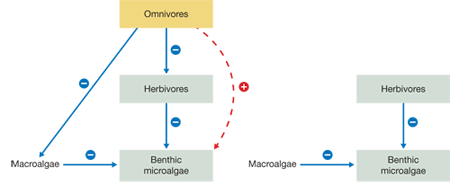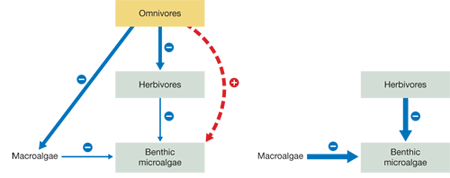Chapter 57
RECAP 57.1
Not necessarily. Ecosystem science is the study of how energy flows and nutrients cycle through the biotic and abiotic environment. The number of species is a descriptor of the biotic environment but does not give any information about the energy flow or nutrient cycling of the ecosystem.
Energy and carbon can be converted into primary production through photosynthesis and chemosynthesis. Photosynthesis involves the capture of radiant energy by plants, algae, and photosynthetic bacteria to be used to fix CO2 into organic compounds. Chemosynthesis involves the capture of energy from inorganic compounds by archaea and bacteria to be used to fix CO2 into organic compounds. Chemosynthesis typically occurs in ecosystems such as hydrothermal vents, hot springs, and soils that lack sunlight and have high concentrations of particular inorganic compounds.
RECAP 57.2
The open ocean has very low average net primary productivity (∼100 g/m2/yr), compared with algal beds and coral reefs (2,500 g/m2/yr). However, because there is so much more open ocean (nearly 70% of Earth’s surface) than there are algal beds and coral reefs (only 0.1% of Earth’s surface), open ocean accounts for a much higher percent of Earth’s NPP.
No, primary producers will not be able to lower global CO2 appreciably. CO2-enrichment experiments show that primary producers can increase their NPP under increased CO2 concentration, but there is a limit. That limit is set by other factors, such as nutrients, light, and water. In addition, the effects may be somewhat counteracted by respiration of CO2 by consumers feeding on primary producers.
Eutrophication can, but does not always, result in the explosive growth of algae, which can severely deplete oxygen (hypoxia) when they decompose. The level of hypoxia is driven by the amount of algae subject to decomposition and the level of oxygen available in the system.
RECAP 57.3
The lake food web would have the higher trophic efficiency. Forest ecosystems have lower trophic efficiency than aquatic systems because much of the NPP in forests is in the form of wood and is unavailable to consumers. In contrast, the lake food web is based on phytoplankton and algae, which are more easily converted to secondary production. Estimates suggest that, on average, only 13 percent of terrestrial biomass is consumed by herbivores, compared with 35 percent in aquatic ecosystems.
The crayfish, which is an ectotherm, would have a higher trophic efficiency than the bear, which is an endotherm. Endotherms maintain higher metabolic rates than ectotherms and thus have less energy left over to devote to growth and reproduction.
The lake with three trophic levels would have the higher NPP. A three-
level food web in which the top carnivore affects an herbivore’s abundance should have higher NPP than a two- or four- level food web in which herbivores have less predator control. Omnivory can also change the way energy is transferred in food webs by essentially “collapsing” trophic levels on one another. A four level food web with a top consumer feeding on both the herbivore and the primary producer should have lower NPP than a four-
level food web without omnivory. Even though the top consumer indirectly benefits the primary producer by feeding at the herbivore level, it partially negates this effect by directly feeding on the primary producer level as well. One hypothesis, which focuses on the amount of NPP entering an ecosystem, suggests that bottom-
up factors can influence the number of trophic levels in an ecosystem. Because tropical rainforests have higher NPP than deserts (see Figure 57.4), they may support more trophic levels if the amount of energy that can sustain populations at higher trophic levels is greater.
RECAP 57.4
The residence time of water depends on the rate at which it moves from one pool to another. Organisms, soil, and rivers all have short water residence times because they have relatively small volumes of water compared with lakes, glaciers, and oceans, and thus the rate of water movement from one pool to the next is much faster.
The concentration of CO2 is rising in the atmosphere and oceans because of fossil-
fuel burning. Today atmospheric CO2 concentration is just over 400 parts per million, the highest recorded in the last 800,000 years. CO2 is a greenhouse gas and, along with other greenhouse gases emitted by fossil- fuel burning, has caused a rise in Earth’s temperature. The increase in CO2 has resulted in a roughly 1°C (1.8°F) rise in global temperatures compared with those from 1981 to 2010. Slightly less than half of the CO2 emitted by burning of fossil fuels has been absorbed by the oceans. CO2 reacts with water to form carbonic acid (H2CO3). As levels of carbonic acid rise, the pH of seawater drops. This increase in acidity can have negative effects on many marine organisms that have calcium carbonate skeletons.
Nitrogen enters the biotic system as atmospheric N2 and is fixed by bacteria into ammonia (NH3). Ammonia is rapidly transformed into ammonium (NH4+), which can then be used by plants and bacteria. Nitrifying bacteria can transform ammonium to nitrate (NO3–), another form of nitrogen that plants and bacteria can use. Denitrifying bacteria take nitrate and convert it back to N2 and N2O gases, which are then released back into the atmosphere. Collectively, this microbial processing of nitrogen is very fast and accounts for about 95 percent of all natural nitrogen flux on Earth, making it a mostly biologically driven cycle.
Unlike nitrogen, phosphorus and sulfur are found in rocks and deep-
sea sediments. They cycle very slowly through the geologic system because they require sedimentary rock formation, uplift, and weathering. Once they reach organisms, they rapidly cycle through the biological component of the ecosystem.
RECAP 57.5
Timber and fibers are provisioning services; coastal protection and erosion control are regulating services; water purification, habitat for fisheries, and carbon sequestration are supporting services; and tourism, recreation, and education are cultural services.
You could leave the mangrove ecosystem intact at the edge of the shoreline so that coastal protection would not be compromised. You could place shrimp farms inland behind these mangrove buffers, where the loss of forest would not have an appreciable effect on protection in extreme storms or tsunamis.
WORK WITH THE DATA, P. 1242


Under increased CO2 and temperature, macroalgae and herbivores increase in biomass. When omnivores are present, this greater biomass will be utilized by omnivores, resulting in a stronger negative interaction between them and their food sources. The stronger negative interaction will lead to a stronger indirect positive effect for benthic microalgae, which will not change in their biomass as a result. However, when omnivores are absent, macroalgae and herbivores will not be kept in check, and their negative interactions with benthic microalgae will grow even stronger, resulting in the decline of benthic microalgae.
The food webs and supporting data in the graphs show that with increased CO2 and temperature, macroalgae and herbivores both increased in biomass, causing negative effects for benthic microalgae (the biomass declined). However, these negative effects for benthic microalgae did not manifest themselves when omnivores were present. By keeping macroalgae and herbivores in check under increased CO2 and temperature, omnivores indirectly benefited benthic microalgae and allowed them to maintain the same biomass as that seen under ambient conditions.
If omnivores ceased feeding on macroalgae, benthic microalgae would decline in biomass because their competitors would increase. But the decline in biomass would be less than if these top consumers were removed altogether. The omnivores would still feed on the herbivores, creating a trophic cascade that would benefit benthic microalgae.
FIGURE QUESTIONS
Figure 57.1 Energy is said to flow through an ecosystem because it moves from the original source (either the sun or inorganic nutrients) to primary producers and consumers, and then is lost as metabolic heat. Nutrients are said to cycle because they continually move between living organisms and the abiotic components of an ecosystem.
Figure 57.8 The consumption and assimilation efficiencies are lower for herbivores because primary producers have structural and chemical defenses that make them harder to consume and digest than animals.
Figure 57.17 Industrial fixation of nitrogen accounts for 30 Tg of the 80 Tg total nitrogen fixed, or 37.5 percent.
APPLY WHAT YOU’VE LEARNED
Sea cucumbers feed on bacteria, benthic marine algae, and decaying organic matter such as feces. Thus they are omnivores, feeding from several levels in the food web. They are also decomposers because they feed on decaying organic matter. Their effect on NPP is hard to predict. By feeding on both primary producers and consumers, sea cucumbers may have little effect on NPP. Bacteria are also decomposers, so sea cucumbers may be feeding on a competitor.
According to the graph, TOC increases steadily over the 8-
week period, but it increases significantly less in sea cucumber−grazed tanks. This indicates that grazing by sea cucumbers decreases TOC by a relatively constant amount over time. The decrease in TOC is evidence that organic carbon is being broken down, or recycled, into smaller inorganic compounds, which become available as nutrients for consumers in the ecosystem. In addition, some of the TOC is lost as CO2 to the system through metabolism and respiration. Thus sea cucumbers have a noticeable effect on nutrient cycling in sediments. There are at least two reasons why TOC continues to increase. First, a specific amount of mussel feces containing TOC is added each day (mirroring, albeit experimentally, what would happen in a mussel farm). Second, as this organic waste is added, bacteria increase as they feed on and decompose the waste. Both waste (dead organic matter) and bacterial biomass (live organic matter) are included in the TOC value. The experiment shows that TOC begins to level off as the experiment proceeds. For the control treatment (black circles) this likely means that, after an initial rise in bacterial population size, the bacteria begin to suffer food limitation. This is also shown in the sea cucumber treatment (clear circles), but with the added effect of sea cucumber grazing on TOC, which includes both waste and bacteria. As sea cucumbers feed, they break down and mineralize the TOC. However, the single cucumber used per tank in these trials is insufficient to cause a significant decline in TOC. It is likely that a larger sea cucumber population would further control TOC; if that population were large enough, it could solve the hypoxia problem.
As TOC levels increase, bacterial levels also increase, as bacteria use TOC as a food source and decompose it. Increased bacterial activity uses up oxygen, often resulting in hypoxia. In this experiment, oxygen levels would be decreasing as TOC increases; oxygen would decrease less as TOC begins to level off. The presence of sea cucumbers would make hypoxia less likely, because they would break down TOC and bacteria. Thus as TOC levels decline, oxygen levels will increase. But in this particular experiment, there is only one sea cucumber per test aquarium. This is not sufficient to break down most of the TOC; therefore oxygen levels are still likely to be too low for a healthy ecosystem.
The aquaculture manager chose to produce mussels in a natural coastal environment. This resulted in food for humans, but in the process he risked polluting the coastal environment. This is a trade-
off between an economic good (food) and an environmental good (a clean, unpolluted coastal environment). The addition of sea cucumbers would definitely be considered an ecosystem service. It uses a natural method (sea cucumbers, a species already present in the ecosystem) to solve a pollution problem, instead of resorting to chemical or physical removal of the TOC, which might cause further pollution and disruption of the environment.